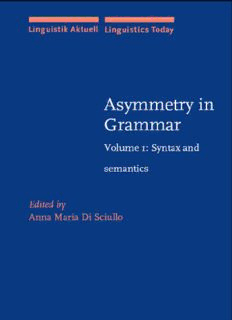
Asymmetry in Grammar, Vol 1: Syntax and Semantics (Linguistik Aktuell Linguistics Today) PDF
Preview Asymmetry in Grammar, Vol 1: Syntax and Semantics (Linguistik Aktuell Linguistics Today)
<ATSKSWVIUIDUEOZTIBYDOTEFLJWFHTECESHHCOOIEN"ETTRRAFI"DGs1O"y""5SLH4m"0i"nT"m>"g"eu"ti2rs2yti0k"inAkGtruaemll/mLianrg:uVisotilcusmTeod1a:yS,yVntoalxumaend57s"emantics" AsymmetryinGrammar Linguistik Aktuell/Linguistics Today Linguistik Aktuell/Linguistics Today (LA) provides a platform for original monograph studies into synchronic and diachronic linguistics. Studies in LA confrontempiricalandtheoreticalproblemsasthesearecurrentlydiscussedin syntax,semantics,morphology,phonology,andsystematicpragmaticswiththe aim to establish robust empirical generalizations within a universalistic perspective. SeriesEditor WernerAbraham UniversityofVienna AdvisoryEditorialBoard GuglielmoCinque(UniversityofVenice) GüntherGrewendorf(J.W.Goethe-University,Frankfurt) LilianeHaegeman(UniversityofLille,France) HubertHaider(UniversityofSalzburg) ChristerPlatzack(UniversityofLund) IanRoberts(CambridgeUniversity) KenSafir(RutgersUniversity,NewBrunswickNJ) LisadeMenaTravis(McGillUniversity) StenVikner(UniversityofAarhus) C.Jan-WouterZwart(UniversityofGroningen) Volume57 AsymmetryinGrammar:Volume1:Syntaxandsemantics EditedbyAnnaMariaDiSciullo Asymmetry in Grammar Volume 1: Syntax and semantics Edited by Anna Maria Di Sciullo UniversityofQuebecatMontreal JohnBenjaminsPublishingCompany Amsterdam(cid:1)/(cid:1)Philadelphia TM ThepaperusedinthispublicationmeetstheminimumrequirementsofAmerican 8 NationalStandardforInformationSciences–PermanenceofPaperforPrinted LibraryMaterials,ansiz39.48-1984. LibraryofCongressCataloging-in-PublicationData Asymmetry in Grammar : Volume 1: Syntax and semantics / edited by Anna Maria Di Sciullo. p. cm.(LinguistikAktuell/LinguisticsToday,issn0166–0829;v.57) Includesbibliographicalreferencesandindex. Contents:v.1.Syntaxandsemantics--v.2.Morphology,phonology,acquisition. 1.Asymmetry(Linguistics)I.DiSciullo,Anne-Maria,1951-II.Linguistikaktuell;Bd. 57-58. P299.A85 A845 2002 415-dc21 2002033272 isbn 90(cid:1)272(cid:1)2778(cid:1)0(v.1Eur.)/1(cid:1)58811(cid:1)306(cid:1)X(v.1US)(Hb;alk.paper) isbn 90(cid:1)272(cid:1)2779(cid:1)9(v.2Eur.)/1(cid:1)58811(cid:1)307(cid:1)8(v.2US)(Hb;alk.paper) isbn 90(cid:1)272(cid:1)2783(cid:1)7(setEur.)/1(cid:1)58811(cid:1)320(cid:1)5(setUS) ©2003–JohnBenjaminsB.V. Nopartofthisbookmaybereproducedinanyform,byprint,photoprint,microfilm,orany othermeans,withoutwrittenpermissionfromthepublisher. JohnBenjaminsPublishingCo.·P.O.Box36224·1020meAmsterdam·TheNetherlands JohnBenjaminsNorthAmerica·P.O.Box27519·Philadelphiapa19118-0519·usa Table of contents Introduction:Asymmetryingrammar 1 AnnaMariaDiSciullo Frenchdefinitedeterminersinindefinitecontexts andasymmetricagreement 11 AntoniaAndroutsopoulouandManuelEspañolEchevarría Restrictiverelativeclausesvs.restrictiveAdjectives:Anasymmetry withintheclassofmodifiers 27 DanielaIsac Asymmetryincase:FinnishandOldRussiannominativeobjects 51 EditJakab Resumptionandasymmetricderivation 85 CedricBoeckx Reconstructingnonconfigurationality 99 JulieAnneLegate Structuralasymmetriesbutsamewordorder:Thedativealternation inSpanish 117 MaríaCristinaCuervo Ontheasymmetryofthespecificationalcopulasentence 145 JacquelineGuéron TheasymmetrybetweendepictivesandresultativesinChinese 165 NiinaZhang Adjunctsandwordorderasymmetries 187 ThomasErnst Wh-asymmetries 209 ManuelaAmbar ThreeargumentsforremnantIPmovementinRomance 251 Jean-YvesPollock Tableofcontents Theclausestructureofextractionasymmetries 279 AnnaMariaDiSciullo,IleanaPaul,andStancaSomesfalean Interpretiveasymmetriesinmajorphrases 301 GregCarlson Configurationalpropertiesofpointofviewroles 315 PeggySpeasandCarolTenny ContrastiveTopicandpropositionstructure 345 ChungminLee Categories,types,andqualiaselection 373 JamesPustejovsky Index 395 Asymmetry in grammar Syntax and semantics AnnaMariaDiSciullo Introduction The restrictions observed in a great variety of languages on the composition of linguisticelements,theirdependencyandtheirlinearorderindicatethatUniver- sal Grammar includesasymmetric relations. This collectionofpapers targetsthe properties of these relations in the different objects generated by the grammar. While asymmetry has mainly been discussed in syntax, the papers in this collec- tionbringtoforethefactthatasymmetryiscentralinsemanticsaswell.Butwhat isasymmetry? Ingenerativegrammar, the term‘asymmetry’ is used in more than oneway. In some cases, it simply refers to differences between two features, categories or configurations.Inothercases,itreferstodifferencesbetweensortsofconstituents, suchassubjectandobject,complementandnon-complement(subjectoradjunct), with respect to the operations of the grammar. This is the case for the so-called ‘asymmetriesofextractionwithrespecttoislands’theoriginofwhichgoesbackto Ross’s(1965)dissertationConstraintsonVariablesinSyntax.Thus,ithasbeenob- servedthatwhiletheextractionofacomplementcontainedinanembeddedclause ispossible,theextractionofasubjectoranadjunctisrarelyacceptable.Thefacts havebeentreatedbydifferentprinciples,includingtheEmptyCategoryPrinciple (ECP) (Chomsky 1981), the Constraint on Extraction Domains (CED) (Huang 1982),Barriers’Minimality(Chomsky1986),RelativizedMinimality(Rizzi1990). The Minimal Link Condition(Chomsky1995)captures therestrictions in terms ofaneconomycondition.TheDerivationbyPhasemodel(Chomsky2001)allows foraderivationalaccountoftheobservedasymmetries. Asymmetry is also used to define certain relations between nodes in con- stituent structure trees. The structural relation of (asymmetric) c-command has beenconsideredtobecentralinsyntax.Thus,xc-commandsy,ifxdoesnotdom- AnnaMariaDiSciullo inatey,andthefirstprojectionwhichdominatesxalsodominatesy;xasymmetri- callyc-commandsy,ifxc-commandsy,butydoesnotc-commandx.Theserela- tionsareconsideredtobedeterminantinthedefinitionofmovement,anaphoric relations, operator-binding and scope relations (Reinhart 1984; Chomsky 1981; Kayne1984;Higginbotham1985;Aoun&Lee1993;Hornstein1999). More recently, the set theoretical notion of asymmetry is used to define the propertiesoftherelationsandtheoperationsofthegrammar.InSetTheory,asym- metryisapropertyofrelationsinasetsuchthatiftheorderedpair<x,y>ispartof thatset,thepair<y,x>isnot.Symmetryandantisymmetryarealsopropertiesof relationsinaset.Thus,symmetryholdsiftheorderedpairs<x,y>and<y,x>are inthatset.Therelationsinasetqualifyasantisymmetric if,inadditiontoasym- metricrelations,thesetmayincludereflexiverelations,suchas<x,x>and<y,y>. AsymmetricandAntisymmetricrelationsarenotsymmetric. The set theoretical notions of asymmetry, symmetry and antisymmetry are used in syntax toderive the properties of observable linguistic phenomena. This isthecaseforKayne’s(1994)LinearCorrespondenceAxiom(LCA),accordingto which the linear orderof terminals of alinguistic expression is a function of the asymmetric c-command relation between all the pairs of non-terminals. Moro’s (2000) Dynamic Antisymmetry hypothesis is a weaker version of the LCA, as it allowsforthederivationofsymmetric relations, orwhat he calls‘pointsofsym- metry’inthederivations.Themotivationformovementistheeliminationofthe pointsofsymmetry. Ithasbeenproposedthatc-commandisnotanelementaryrelation,butcanbe derivedfrom theproperties ofderivations (Epstein1995;Frank &Vijayashankar 1995;Reuland1998).Asymmetricc-commandfallsoutinanaturalwayfromthe operationsofthegrammarintheMinimalistFramework(Chomsky1998),where asymmetric c-command doesnotplayaroleincoresyntax.This relationissub- sumed under the more elementary ‘sister’ and ‘contain’ relations, derived by the operationMerge. Thenotionsofasymmetryandsymmetryarealsousedinthedefinitionsofthe operationsofthegrammar.ThusinChomsky(1995)set-Mergediffersfrompair- Merge.Thefirst,whichbasicallyderiveshead-complementstructures,issaidtobe asymmetric operation,aseitheroneortheothersyntacticobjectthatundergoes theoperationprojectsits features, whereas the second,which derivesadjunction structures, is asymmetric. The difference between categories and segments is ex- pressedintermsofsettheoreticaltermsinthisframework.Theoperationsofthe grammar are also defined in terms of asymmetry. Thus, Move is asymmetric in thatonlythecategorytargetedbyMoveprojectsitsfeaturesintheconfigurationof whichitispart. Furthermore,thenotionofasymmetryispartofthederivationsofarguments andadjuncts.ThisisthecaseforthepropertiesofargumentsinHaleandKeyser’s Asymmetryingrammar (1993–1998) theory, where the restrictions on argument structure as well as ar- gument structure alternations follow from the limitations due to the [Specifier [head Complement]] asymmetries. The properties of adjuncts also bring about important issues with respect to the asymmetry of these projections. In fact, the nature of the asymmetry of adjuncts is subject to debate. It is not clear, if they are external to the VP or if some adjuncts are part of the VP, whether they are Chomsky-adjoinedtoaprojectionorgeneratedinthespecifieroffunctionalpro- jections(Cinque1999),whethertherecanbeonlyoneadjunct/specifierperprojec- tion(Kayne1994;Moro2000)orifmultipleadjunctsarepossible(Chomsky1995; Ura1996),andalsowhetheradjunctsaredistinctprojectionsfromspecifiers. Arelatedsetofquestionsarisewithrespecttotheasymmetryofthefullpro- jectionofahead,orphraseddifferently,therecursionofprojectionsofthesame sort, giving rise to further articulation of the verbal structure, as in Chomsky’s (1998) small vP, as well as to other projections, including functional projections suchasDP,CPandhigherfunctionalprojectionsattheleftperipheryofsentences. (Ambar2000;Rizzi1997;Pollock,Munaro,&Poletto1999).Theseworksarguein favorofafine-grainedarticulationofconstituentstructure,whichcanbeviewed asaparticularcaseofthebasicasymmetryofsyntax. Whileresearchhasbeenmainlyfocussedonthepropertiesofsyntacticasym- metries, there have also been results in the works on asymmetry in semantics. Inthisarea,thenotionofasymmetric c-command hasbeenproposedtobecru- cialinthedeterminationofanaphoric(Reinhart1983;Reinhart&Reuland1993; Reuland2001)and binding relations (Chomsky1981, 1986;Grodzinsky &Rein- hart1993).Thenotionofco-indexation,whichwaspartofthebindingrelations, hasbeenshowntobeasymmetric inHigginbotham(1985),whoproposedtore- place it by the unidirectional Linking relation. The interpretation of indefinites andquantificationalNPshasbeenproposedtomatchthegeometryofphrasalpro- jection in Diesing (1992).Asymmetric relations have also been proposedfor the articulationofothersemanticrelations,includingthepredicate-argumentrelation (Hale&Keyser1993),themodificationrelation(Cinque1999),aswellastemporal relations(Stowell1995). Ifphonologicalasymmetriesandmorphologicalasymmetriesexist,asargued inDiSciullo(1995,2003);KeyserandRoeper(1995);DresherandvanderHulst (1998);Dresherand Rice(1993);Hulst(1984,1999,2000);Piggott(1999,2000); Rice(1992);RiceandAvery(1993);Raimy(2000),aswellassyntacticandseman- ticasymmetries, thequestionthatcomestomindiswhetherasymmetry isgiven byUniversal Grammar. It might be the case that asymmetry is part of the initial state of the language faculty, enabling human beings to developthe grammar of the language towhich theyare exposed, to interpret and toquicklygenerate the expressionsofthislanguageinarelativelyshortperiodoftime.
Description: